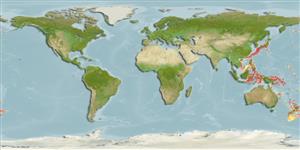Common names from other countries
>
Gadiformes (Cods) >
Macrouridae (Grenadiers or rattails)
Etymology: Hymenocephalus: Named for its transparent membrane-like head covering (‘‘hymen head’’) and fragile nature of head bones (Ref. 100825).
More on authors: Jordan & Gilbert.
Environment: milieu / climate zone / depth range / distribution range
Ecologia
marinhas batidemersal; intervalo de profundidade 220 - 810 m (Ref. 41299). Deep-water
Western Pacific: southern Japan to the Philippines.
Tamanho / Peso / Idade
Maturity: Lm ? range ? - ? cm
Max length : 14.0 cm TL macho/indeterminado; (Ref. 559)
Descrição breve
Morfologia | Morfometria
This species is distinguished by the following characters: pelvic fin rays 11 (rarely 12); pectoral fin rays 13-15; projecting snout, 20-25% HL; no barbel; moderate orbit diameter, 30-33% HL; infraorbital width 13-15% HL; moderately long preopercular supporter, with obtuse angle at rear margin, 3-5% HL; 20-26 gill rakers; ventral striae reaching to ½ distance from pelvic fin bases to periproct; otolith has moderately high predorsal lobe, with colliculi separated, widely placed across collum, terminating at some distance from anterior and posterior rims of otolith; otolith length to height (OL:OH), 1.05-1.1; total colliculum length to pseudocolliculum length (TCL:PCL), 2.4-2.6 (Ref. 98298).
Minimum depth from Ref. 26282.
Life cycle and mating behavior
Maturidade | Reprodução | Desova | Ovos | Fecundidade | Larvas
Masuda, H., K. Amaoka, C. Araga, T. Uyeno and T. Yoshino, 1984. The fishes of the Japanese Archipelago. Vol. 1. Tokai University Press, Tokyo, Japan. 437 p. (text). (Ref. 559)
Categoria na Lista Vermelha da IUCN (Ref. 130435)
CITES (Ref. 128078)
Not Evaluated
Ameaça para o homem
Harmless
Utilização humana
Mais informação
Idade/TamanhoCrescimentoComprimento-pesoComprimento-comprimentoFrequência de comprimentoMorfometriaMorfologiaLarvasDinâmica larvarRecrutamentoAbundância
ReferênciasAquaculturaPerfil para aquaculturaEstirpesGenéticaElectrophoresesHereditariedadeDoençasProcessamentoMass conversion
Ferramentas
Relatórios especiais
Descarregue XML
Fontes da internet
Estimates based on models
Preferred temperature (Ref.
115969): 6.9 - 13, mean 9.3 (based on 172 cells).
Phylogenetic diversity index (Ref.
82804): PD
50 = 0.5000 [Uniqueness, from 0.5 = low to 2.0 = high].
Bayesian length-weight: a=0.00219 (0.00111 - 0.00431), b=3.20 (3.03 - 3.37), in cm Total Length, based on LWR estimates for this (Sub)family-body shape (Ref.
93245).
Nível Trófico (Ref.
69278): 3.2 ±0.40 se; based on food items.
Resiliência (Ref.
120179): Médio, tempo mínimo de duplicação da população 1,4 - 4,4 anos (Assuming tmax>3).
Fishing Vulnerability (Ref.
59153): Low vulnerability (10 of 100).
